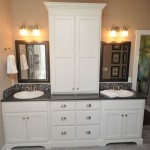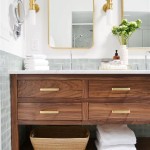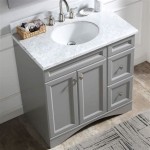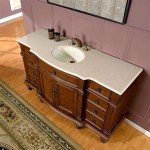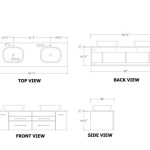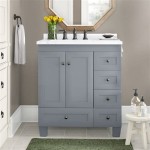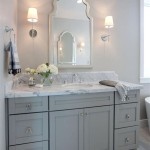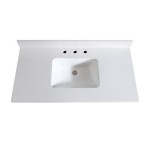Floating Bathroom Vanity Without Sink
Floating bathroom vanities, characterized by their wall-mounted design, offer a contemporary aesthetic and practical advantages for bathrooms of all sizes. While frequently sold with integrated sinks, opting for a floating vanity *without* a sink opens up a world of design possibilities and customization options. This article explores the benefits, design considerations, installation process, and material choices associated with floating bathroom vanities without sinks.
Enhanced Design Flexibility
One of the primary advantages of choosing a floating vanity without a sink is the design freedom it provides. Decoupling the vanity from the sink allows homeowners to select a sink that perfectly complements their aesthetic vision, rather than being limited to pre-configured sets. Vessel sinks, undermount sinks, and integrated sinks can all be paired with a floating vanity, offering a wide range of styles, materials, and sizes. This flexibility empowers homeowners to create a truly unique bathroom design.
Furthermore, the absence of a pre-determined sink allows for greater creativity in faucet selection. Wall-mounted faucets, widespread faucets, and single-handle faucets can all be considered, depending on the chosen sink and overall design scheme. This freedom extends to other bathroom accessories as well, allowing for seamless integration of soap dispensers, towel bars, and other elements.
Space Optimization and Accessibility
Floating vanities, by their very nature, create a sense of spaciousness in the bathroom. The absence of a base cabinet resting on the floor opens up the visual field and makes the room appear larger. This is particularly beneficial in smaller bathrooms where maximizing space is crucial. The open space beneath the vanity also simplifies cleaning, reducing dust accumulation and facilitating easy access for mopping or vacuuming.
Beyond visual spaciousness, floating vanities can also contribute to improved accessibility. The open space beneath the vanity allows for wheelchair access, making the bathroom more user-friendly for individuals with mobility challenges. This feature makes floating vanities a popular choice in universal design principles, promoting inclusivity and ease of use for everyone.
Installation Considerations and Material Choices
Installing a floating vanity without a sink requires careful planning and execution. The wall must be capable of supporting the weight of the vanity and its contents. Proper wall framing and anchoring are essential to ensure stability and prevent the vanity from detaching. Consulting a professional contractor is recommended, especially if there are concerns about the structural integrity of the wall.
The installation process typically involves securing brackets or mounting plates to the wall studs, followed by attaching the vanity to these supports. Accurate measurements and precise leveling are crucial to ensure a secure and aesthetically pleasing installation. The plumbing connections for the chosen sink will also need to be considered during the installation process.
Floating vanities are available in a variety of materials, each offering distinct aesthetic and functional characteristics. Wood, with its natural warmth and versatility, remains a popular choice. Various wood species, finishes, and stains offer a wide range of design possibilities. Engineered wood products, such as MDF and plywood, provide a cost-effective and durable alternative to solid wood.
Modern materials like glass, concrete, and metal are also gaining popularity. Glass vanities create a sleek and contemporary look, while concrete offers a rugged, industrial aesthetic. Metal vanities, often crafted from stainless steel or aluminum, provide a durable and minimalist design option.
Maintenance and Durability
Proper maintenance is essential to preserving the appearance and functionality of a floating vanity. Regular cleaning with appropriate cleaning agents helps prevent the buildup of grime and mildew. Avoiding harsh chemicals and abrasive cleaners helps protect the finish and maintain the vanity’s appearance over time.
The durability of a floating vanity depends on the chosen material and the quality of construction. Solid wood vanities are generally durable and long-lasting, while engineered wood products offer good durability at a lower price point. Glass, concrete, and metal vanities are also durable and resistant to wear and tear, making them suitable for high-traffic bathrooms.

Upiker Modern 18 3 In W X 30 D 19 7 H Floating Bath Vanity Imitative Oak With White Ceramic Top Up2210bcb30024 The Home

Domani Millhaven 48 In W X 19 D 22 H Single Sink Floating Bath Vanity Caramel Mist With White Cultured Marble Top B48x20243 The Home

Diy Floating Bathroom Vanity Remodelando La Casa

Why Consider A Floating Bathroom Vanity Unique Vanities

Virtu Usa Jd 50754 Wg 001 Finley 54 In Bathroom Vanity Set

White Floating Bathroom Vanity Crystal Cabinets

Eviva Santa Monica 30 In W X 22 D 16 H Floating Bathroom Vanity Rosewood With White Solid Surface Top Evvn555 30rswd The Home

Nameeks Block24 By Nameek S Block Floating Bathroom Vanity Modern 39 Grey Mist Thebathoutlet

Pin En Baños Modernos

31 Quot Black Amp White Floating Bathroom Vanity Faux Marble Top Ceramic Ves
